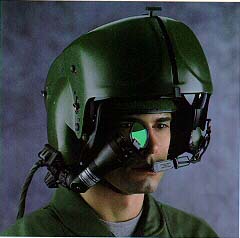

A helmet-mounted display (HMD) is a headworn device that uses displays and optics to project imagery and/or symbology to the eyes.[1][2][3] It provides visual information to the user where head protection is required – most notably in military aircraft. The display-optics assembly can be attached to a helmet or integrated into the design of the helmet. An HMD provides the pilot with situation awareness, an enhanced image of the scene, and in military applications cue weapons systems, to the direction their head is pointing. Applications which allow cuing of weapon systems are referred to as helmet-mounted sight and display (HMSD) or helmet-mounted sights (HMS).
- ^ Rash, C. E.; Russo, M. R.; Letowski, T. R.; Schmeisser, E. T. (2010). Helmet-Mounted Displays: Sensation, Perception and Cognition Issues. Fort Rucker AL: U. S. Army Aeromedical Research Laboratory. ISBN 978-0-615-28375-3.
- ^ Kocian, Dean F.; Task, H. Lee (1995). "Visually coupled systems hardware and the human interface". In Barfield, Woodrow; Furness, Thomas A. (eds.). Virtual Environments and Advanced Interface Design. Oxford University Press. ISBN 0-19-507555-2.
- ^ Rash, Clarence E. (2001). "Introductory Overview". In Rash, Clarence E. (ed.). Helmet-Mounted Displays: Design Issues for Rotary-Wing Aircraft. U.S. Army Medical Research and Materiel Command.